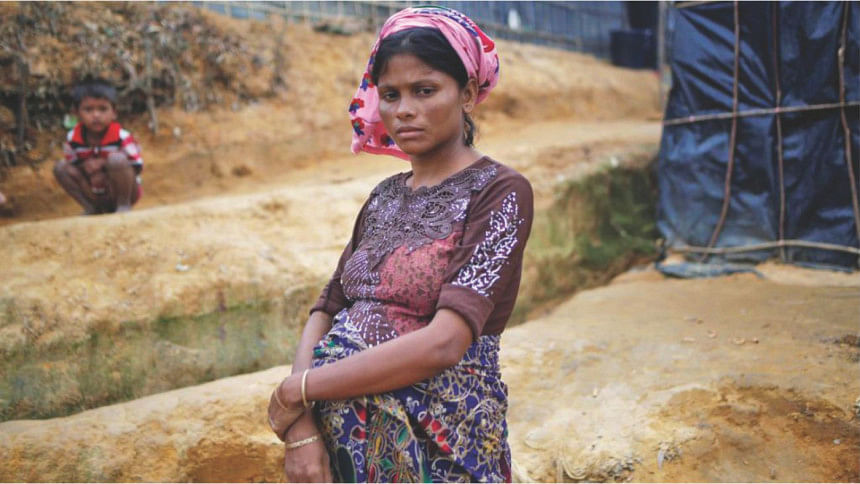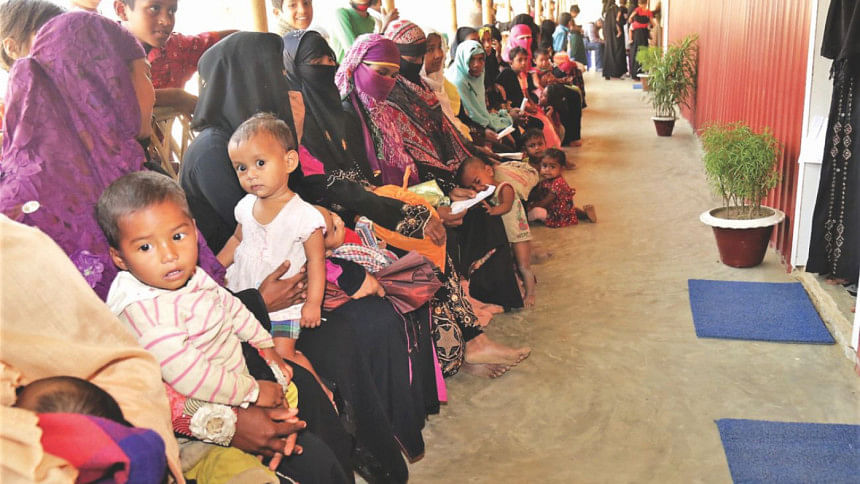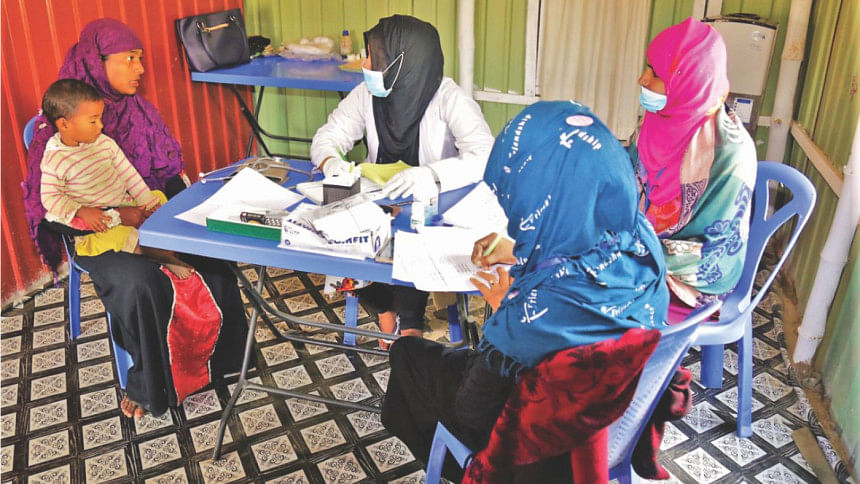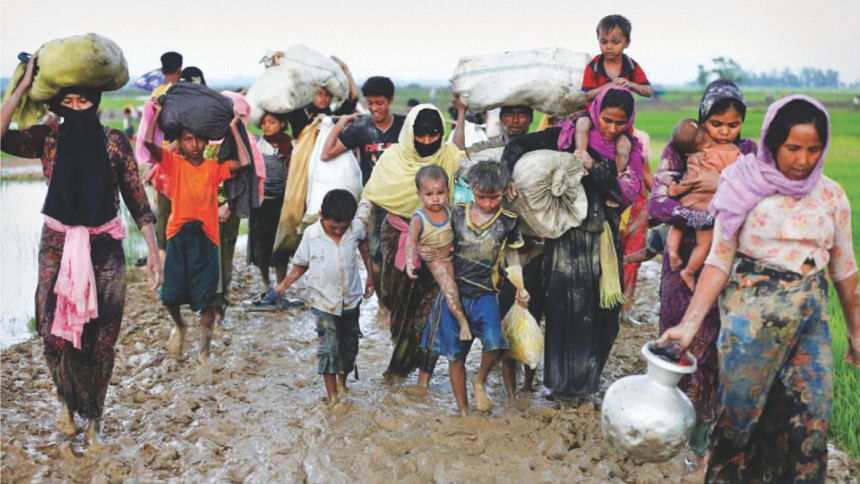Bringing life into a refugee camp

Giving birth was nothing new to 32-year-old Somuda, a mother of six. The only extraordinary circumstance was that she now lived in a small shack on a hilltop of Balukhali which merges with the Kutupalong settlements to make the largest refugee camp in the world.
Somuda, along with hundreds of thousands of other refugees, had made the journey across the border fleeing a brutal military crackdown in Rakhine. Though she was taking injectables as a form of birth control back in Myanmar, she missed an injection in the upheaval while she was displaced. She was carrying her seventh child when she set foot in the camps.
The day before she gave birth, Somuda visited the clinic she regularly went to for check-ups and other treatment. The midwife on duty found no complications on examining her; her labour pains were just starting. But clinics and NGO staff, with the exception of a couple of clinics with round-the-clock presence, had to close up and leave the camps by 5pm. She was administered an injection after which the pain subsided and was kept under observation for an hour. Somuda was then sent home because the clinic was about to close. If something untoward were to happen, clinic staff told her to go to a government health complex right beside the camp or the Médecins Sans Frontières (MSF) clinic, both open 24/7.
She went into labour in the early morning and delivered a boy, with the presence of a dai (a traditional birth attendant among the Rohingya women). But by morning, she was still bleeding heavily and experiencing pain ("pete betha"), sending her husband running to the clinic in the morning as soon as it opened. The midwife, on visiting Somuda's shelter, found her to be in postpartum hemorrhage. Unable to control the excessive bleeding, the midwife advised Somuda's husband that she would have to be taken to the clinic, and if necessary, to the "big" hospital [Cox's Bazar Sadar]. "But if I don't take her to the hospital she might die," said the midwife to Somuda's husband.
Somuda was given primary treatment at the clinic and then taken by ambulance to the Ukhiya health complex. The doctor at the centre was on maternity leave and Somuda was again moved, finally, this time to a hospital. By this time, she was becoming anemic and would require blood, which could be gotten at the Sadar, almost an hour's ride away from the camps in Ukhiya.What would have been relatively manageable in a healthcare facility, turned into a long, painful postpartum experience for Somuda.
Somuda subsequently recovered. But she admitted to the midwife, "Apa, if it had happened in the morning and not at dawn, I would have come to the clinic." When asked why she hadn't gone to the clinics open at the time, she said, "All my children were born at home. I didn't think it necessary to go to the hospital."
Giving birth in the camps
It is difficult to get concrete data on how many women and girls in the camps are pregnant—aid agencies estimate varying numbers, which keep changing. MSF estimates there are 28,000 pregnant women in the camps, working off the latest population count in April and an initial survey which estimated that 4.9 percent of the female population in the camps were expecting. UNFPA however predicts that close to 60,000 women are pregnant in the camps.
But till date [between August 25 and April 30], MSF has seen 1,102 deliveries in its facilities in the camps. According to the Ukhiya upazila health officer, Md Abdul Mannan, till date, 86 births have taken place in the upazila health complex. The International Federation of Red Cross and Red Crescent Societies (IFRC), the Malaysian Field Hospital, Friendship NGO, and the Hope Foundation also provide health services to expectant mothers.
But few come to avail these services, partly due to a lack of information about the care available. "It could be a combination—it could be they don't wish to seek out services available or it could also be a part of what they faced in Myanmar, not having access to healthcare. It's something we need to improve our understanding of," says Melissa How, medical coordinator of MSF in Cox's Bazar.
In the camps, UNFPA estimates that only 22 percent of births are taking place in health care facilities. Dr Rafi AH Siddique, who heads four medical centres of an NGO, has overseen just over 100 deliveries at the birthing center since it began operations in November last year. This is only a drop in the bucket of the numbers predicted by agencies, because most births are still happening in the makeshift shelters in which the refugees are living.
"The refugee women are more comfortable delivering at home," says Dr Siddique. But complications such as what Somuda experienced can result in long-term implications if care is not received in time. "We are conducting extensive counselling for women to come deliver at a healthcare facility," says Dr Siddique.

Agencies are now working with the dais, who usually assist those in labour at home, to identify pregnant women in the camps. But encouraging them to come to the facilities to deliver is challenging and continues to require much outreach, says How. They hope that when the time comes, expecting women will be inclined to reach out to these attendants, who they know personally, to ask for assistance. The attendants are being trained to recognise signs of complications and bring these women to a healthcare facility.
Dr Siddique recently saw twins delivered in a birthing centre outside Kutupalong camp. Once 30-year-old Amina Khatun* learned that a C-section would be necessary because it was a breech delivery, she was hesitant to go through with the operation and left, saying she would need to go get consent from her family.
"She came back the next day in the evening and said she was experiencing labour pains and wanted to go ahead with the C-section," recalls Dr Siddique. His team immediately swung into action and the centre's gynecologist delivered a boy and a girl, both healthy.
Sharifa, 23, a midwife who works with Rohingya women in the camps, says they only see a fragment of the births taking place in the camps. "They have traditional dais among them, older Rohingya women, who come and deliver babies in their homes. They are effective but are not always veryhygienic."

In a discussion with several Rohingya women in Kutupalong camp, the refugees said they preferred not to give birth at, hospitals back in Myanmar. They had no trust in government healthcare, meaning birth control methods and family planning services were rarely accessed. Hesitancy about going to the hospital, surgery, or even birth control is not uncommon, say medical workers on the ground.
It has also been difficult to instill awareness of family planning, says Dr Siddique. Amina, for instance, is now a mother of five and does not use birth control. "Initially, we could not get anyone to adopt family planning methods. Refugees, especially males, would throw away condoms, unused. They would say that family planning methods are not for males, only for females," says Dr Siddique.
Sharifa echoes Dr Siddique. "Many of the women we speak to about family planning say they don't want to get rid of something given by Allah."
Birth control is slowly being accepted only now after extensive counselling by agencies. Oral contraceptive pills, condoms and injectables are now being provided to willing refugees. "We have around 25 to 30 Rohingya males who are now accessing birth control regularly," says Dr Siddique.
What medical care is available, too, is not sufficient with some having operating facilities and others not. MSF for example does not have an operation theatre and refers complications to Cox's Bazar Sadar. Others which can conduct operations and C-sections do not have facilities for neonatal care.

Babies born out of rape
This May marks nine months since the influx of refugees following brutal military operations the UN has called ethnic cleansing in Myanmar. These include physical and psychological scars documented by medics and humanitarian staff from testimonies of Rohingya women of widespread use of sexual violence by members of the Myanmar's armed forces and local militias—including rape, gang rape, sexual slavery, public rape, forced nudity and invasive body searches.
MSF health surveys revealed 3.3 percent of the female refugees had experienced or witnessed sexual violence between August 25 and September 24, prior to their arrival in Bangladesh. MSF notes that this is likely "an under-representation, given that sexual violence is often under-reported due to associated stigma and shame."
"From August till the end of March, we had seen 311 victims of sexual violence come in. It [the number] is very low. Amongst that, we had 162 who had survived rape," says How, of the numbers seen in MSF's facilities.
"At the start of the influx, MSF's midwives had some women disclose that they had been raped, but for the most part, we don't see it and we don't know [how many there are]," says How, of rape survivors seeking out care.
Reluctance to reveal their stigma and shame and barriers to accessing medical facilities have made it extremely difficult to come up with an accurate number of survivors of rape and pregnancies conceived of rape.

At the beginning of the year, aid agencies had projected that 48,000 babies would be born in 2018 in the refugee camps in Cox's Bazar to which some 700,000 Rohingya Muslims have fled. Nine months on, women who were raped at the height of the military crackdown in August 2017, are due to give birth in the coming weeks. As seen in Somuda's case, providing timely medical care to expecting women is challenging, but complicated further by women giving birth outside health facilities and victims of sexual violence who choose not to disclose their pregnancies.
Abortion is illegal in Bangladesh except to save the mother's life, but menstrual regulation (MR) is performed up to 12 weeks of pregnancy, under Bangladeshi law. For those who come after their first trimester, says How, "They receive counselling to support them through the process of their pregnancy; at that point it's too late." They are essentially turned away from hospitals and clinics.
Left with no other option, there have been cases of Rohingya women who took matters into their own hands. "It happens. We see women come in with bleeding in late pregnancy because they have tried to self-terminate at home," says How. These methods, often comprising traditional medicine and other alternatives, are unsafe and post-abortion care becomes necessary.
But the risk of such unsafe procedures is not being addressed and these women not kept track of. MSF performs MR, as does Dr Siddique who has supervised 18 procedures at his centres till date. But, he says, it is impossible to say whether these women wanted an abortion because the child was conceived from rape.
For those forced to continue with their pregnancies, the spate of births should be seen around this time. But this trend has not materialised yet, says How. "We have not seen any increase in the number of deliveries in our facilities through the month of April."
With a few weeks yet to go, the number of Rohingya rape survivors remains unclear as is the number of pregnancies in the camps. It proves a daunting task when victims of sexual violence do not want to speak of what they suffered and when traditional methods of outreach by agencies are failing to convince Rohingya women to access healthcare facilities.
* Name has been changed to protect the identity of the woman.





Comments